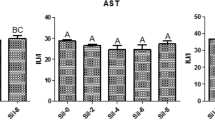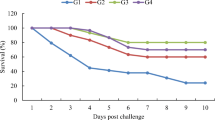Abstract
This study was carried out to evaluate the potential antibacterial and immunomodulatory effects of the dietary acidifier propionic acid (PA) when given alone or in combination with oxytetracycline (OTC) on Nile tilapia (Oreochromis niloticus). Apparently healthy O. niloticus (n = 240; 52 ± 3.75 g) were randomly allocated into four equal groups (n = 60/group): control group fed a basal diet alone and the other three groups fed basal diets supplemented with either PA (200 mg /kg of diet, PA group) or OTC (500 mg/kg of diet, OTC group) alone or in combination (PA + OTC group). Each group was subdivided into two subgroups (n = 30/subgroup, each subgroup had triplicate of 10 fish); subgroup (A) was used to evaluate the antibacterial effects with the aforementioned 2 weeks feeding regime, and subgroup (B) was used to evaluate the immunomodulatory effects against Aeromonas hydrophila infection with similar 2 weeks feeding regime. Among the four groups, PA + OTC group showed the highest significant (p < 0.0001) antibacterial activity as indicated by widest inhibition zones against A. hydrophila and lowest total gastrointestinal bacterial counts. Additionally, this group had the best immunomodulatory effect as noticed by a significant (p < 0.05) increase in total serum protein, globulin, IgM, phagocytic activity and index, lysosome activity, and significant (p < 0.05) upregulation in the expression levels of immunity-related genes (MHC I, MHC IIA, MHC IIB, Tlr7, IgM heavy chain, TNFα, and IL1β) in head-kidney. Notably, the combined dietary PA and OTC improved the hematological parameters and reduced the oxidative damage of hepatopancreas and head-kidney induced by OTC. This data suggests dietary PA as potential adjuvant to OTC in O. niloticus diets to get maximal antibacterial and immunomodulatory effects.






Similar content being viewed by others
References
Abdelhadya DH, El-Magd MA, Elbialy ZI, Saleh AA 2017 Bromuconazole-induced hepatotoxicity is accompanied by upregulation of PXR/CYP3A1 and downregulation of CAR/CYP2B1 gene expression. Toxicol Mech Methods, 1-7
Abo-Al-Ela HG, El-Nahas AF, Mahmoud S, Ibrahim EM (2017) Vitamin C modulates the Immunotoxic effect of 17alpha-Methyltestosterone in Nile Tilapia. Biochemistry 56:2042–2050
Al-Harbi AH, Naim Uddin M (2004) Seasonal variation in the intestinal bacterial flora of hybrid tilapia (Oreochromis niloticus×Oreochromis aureus) cultured in earthen ponds in Saudi Arabia. Aquaculture 229:37–44
Alday-Sanz V, Corsin F, Irde E, Bondad-Renantaso MG 2012 Survey of the use of veterinary medicines in aquaculture. In: Improving biosecurity through prudent and responsible use of veterinary medicine in aquatic food production (ed. by M.G. Bondad-Renantaso, J.R. Arthurs & R.P. Subasinghe), pp. 29–45. FAO fisheries and aquaculture technical paper 547, FAO, Rome, Italy
Anuta JD, Buentello A, Patnaik S, Lawrence AL, Mustafa A, Hume ME, Gatlin DM, Kemp MC (2011) Effect of dietary supplementation of acidic calcium sulfate (Vitoxal) on growth, survival, immune response and gut microbiota of the Pacific white shrimp, Litopenaeus vannamei. J World Aquacult Soc 42:834–844
Baruah K, Sahu NP, Pal AK, Jain KK, Debnath D, Mukherjee SC (2007) Dietary microbial phytase and citric acid synergistically enhances nutrient digestibility and growth performance of Labeo rohita (Hamilton) juveniles at sub-optimal protein level. Aquac Res 38:109–120
Croisetiere S, Tarte PD, Bernatchez L, Belhumeur P (2008) Identification of MHC class IIbeta resistance/susceptibility alleles to Aeromonas salmonicida in brook charr (Salvelinus fontinalis). Mol Immunol 45:3107–3116
da Silva BC, Vieira FdN, Mouriño JLP, Ferreira GS, Seiffert WQ (2013) Salts of organic acids selection by multiple characteristics for marine shrimp nutrition. Aquaculture 384-387:104–110
Defoirdt T, Boon N, Sorgeloos P, Verstraete W, Bossier P (2009) Short-chain fatty acids and poly-β-hydroxyalkanoates: (new) biocontrol agents for a sustainable animal production. Biotechnol Adv 27:680–685
Defoirdt T, Halet D, Sorgeloos P, Bossier P, Verstraete W (2006) Short-chain fatty acids protect gnotobiotic Artemia franciscana from pathogenic Vibrio campbellii. Aquaculture 261:804–808
El-Hady MA, Ahmed HA (2014) Multiplex PCR for rapid detection of infectious bacterial fish diseases with special reference to Aeromonas hydrophila and Yersinia ruckeri in Egypt. Anim Health Res J 2:284–290
El-Magd MA, Kahilo KA, Nasr NE, Kamal T, Shukry M, Saleh AA 2016a A potential mechanism associated with lead-induced testicular toxicity in rats. Andrologia 49 https://doi.org/10.1111/and.12750
El-Magd MA, Saleh AA, Abdel-Hamid TM, Saleh RM, Afifi MA (2016b) Is really endogenous ghrelin a hunger signal in chickens?: association of GHSR SNPs with increase appetite, growth traits, expression and serum level of GHRL, and GH. Gen Comp Endocrinol 237:131–139
Fujiki K, Matsuyama H, Yano T (1994) Protective effect of sodium alginates against bacterial infection in common carp, Cyprinus carpio L. J Fish Dis 17:349–355
Gupta MV, Acosta BO (2004) A review of global tilapia farming practices. Aquaculture Asia Magazine 10:7–12
Haque M, Chowdhury R, Islam K, Akbar M (2012) Propionic acid is an alternative to antibiotics in poultry diet. Bangladesh J Anim Sci 38:8
Hofmann MJ, Bracamonte SE, Eizaguirre C, Barluenga M (2017) Molecular characterization of MHC class IIB genes of sympatric Neotropical cichlids. BMC Genet 18:15
Kesarcodi-Watson A, Kaspar H, Lategan MJ, Gibson L (2008) Probiotics in aquaculture: the need, principles and mechanisms of action and screening processes. Aquaculture 274:1–14
Khajepour F, Hosseini SA (2012) Citric acid improves growth performance and phosphorus digestibility in Beluga (Huso huso) fed diets where soybean meal partly replaced fish meal. Anim Feed Sci Technol 171:68–73
Kumar H, Kawai T, Akira S (2011) Pathogen recognition by the innate immune system. Int Rev Immunol 30:16–34
Kwon YM, Ricke SC (1998) Induction of acid resistance of Salmonella typhimurium by exposure to short-chain fatty acids. Appl Environ Microbiol 64:3458–3463
Lim C, Klesius PH, Lückstädt C (2010) Effects of dietary levels of potassium diformate on growth, feed utilization and resistance to Streptococcus iniae of Nile tilapia, Oreochromis niloticus. In: Abstract in proceedings of the 14th international symposium on fish nutrition and feeding. Qingdao, China
Livak KJ, Schmittgen TD (2001) Analysis of relative gene expression data using real-time quantitative PCR and the 2(−Delta Delta C(T)) method. Methods 25:402–408
Luthman J, Jacobsson SO (1985) The effect of citric acid on the availability of tetracyclines in calves. Nordisk Veterinaermedicin 37:22–26
Ng W-K, Koh C-B (2017) The utilization and mode of action of organic acids in the feeds of cultured aquatic animals. Rev Aquac 9:342–368
Ng W-K, Koh C-B, Sudesh K, Siti-Zahrah A (2009) Effects of dietary organic acids on growth, nutrient digestibility and gut microflora of red hybrid tilapia, Oreochromis sp., and subsequent survival during a challenge test with Streptococcus agalactiae. Aquac Res 40:1490–1500
Piertney SB, Oliver MK (2006) The evolutionary ecology of the major histocompatibility complex. Heredity (Edinb) 96:7–21
Reda RM, Ibrahim RE, Ahmed E-NG, El-Bouhy ZM (2013) Effect of oxytetracycline and florfenicol as growth promoters on the health status of cultured Oreochromis niloticus. Egypt J Aqua Res 39:241–248
Reda RM, Mahmoud R, Selim KM, El-Araby IE (2016) Effects of dietary acidifiers on growth, hematology, immune response and disease resistance of Nile tilapia, Oreochromis niloticus. Fish Shellfish Immunol 50:255–262
Saleh AA, El-Magd MA (2018) Beneficial effects of dietary silver nanoparticles and silver nitrate on broiler nutrition. Environ Sci Pollut Res 25:27031–27038. https://doi.org/10.1007/s11356-018-2730-7
Sharawy ZZ, Thiele R, Abbas EM, El-Magd MA, Hassaan MS, Peter C, Schmidt J, Saborowski R, Goda AMA-S, Slater MJ (2017) Antioxidant response, body composition of whiteleg shrimp Litopenaeus vannamei co-cultured with Nile tilapia Oreochromis niloticus in recirculating aquaculture. Aquacult Environ Interactions 9:257–268
Surya KS, Basanta KD, Bibhuti BP (2014) Isolation, biochemical characterization, antibiotic susceptibility study of Aeromonas hydrophila isolated from freshwater fish. Int J Curr Microbiol App Sci 3:259–267
Tafalla C, Novoa B, Alvarez JM, Figueras A (1999) In vivo and in vitro effect of oxytetracycline treatment on the immune response of turbot, Scophthalmus maximus (L.). J Fish Dis 22:271–276
Tanekhy M, Khalil R, Hofi H, Hashish E (2016) The biochemical, pathological and immunological effectiveness of commercial probiotics in Nile tilapia Oreochromis niloticus. Pakistan J Zool 48:1269–1282
Trushenski JT, Aardsma MP, Barry KJ, Bowker JD, Jackson CJ, Jakaitis M, McClure RL, Rombenso AN (2018) Oxytetracycline does not cause growth promotion in finfish. J Anim Sci 96:1667–1677
Wang JP, Lee JH, Yoo JS, Cho JH, Kim HJ, Kim IH (2010) Effects of phenyllactic acid on growth performance, intestinal microbiota, relative organ weight, blood characteristics, and meat quality of broiler chicks. Poult Sci 89:1549–1555
Wanner M, Walker W, Sutter HM, Riond JL, Broz J (1991) Influence of dietary citric acid and calcium on the bioavailability of orally administered chlortetracycline in piglets. J Veterinary Med Ser A 38:755–762
Wyatt RD, Miller BL (1985) Effect of mixed organic acid administration on blood levels of chlortetracycline in broiler chicks. Poult Sci 64:59–64
Yin Z, Lam TJ, Sin YM (1997) Cytokine-mediated antimicrobial immune response of catfish,Clarias gariepinus, as a defence against Aeromonas hydrophila. Fish & Shellfish Immunol 7:93–104
Author information
Authors and Affiliations
Corresponding authors
Ethics declarations
Conflict of interest
The authors declare that they have no conflict of interest.
Additional information
Responsible editor: Philippe Garrigues
Rights and permissions
About this article
Cite this article
El-Adawy, M., El-Aziz, M.A., El-Shazly, K. et al. Dietary propionic acid enhances antibacterial and immunomodulatory effects of oxytetracycline on Nile tilapia, Oreochromis niloticus. Environ Sci Pollut Res 25, 34200–34211 (2018). https://doi.org/10.1007/s11356-018-3206-5
Received:
Accepted:
Published:
Issue Date:
DOI: https://doi.org/10.1007/s11356-018-3206-5




